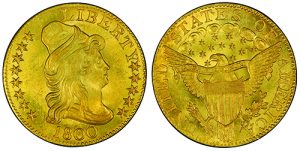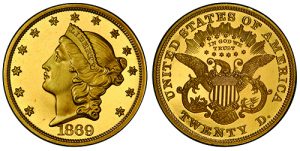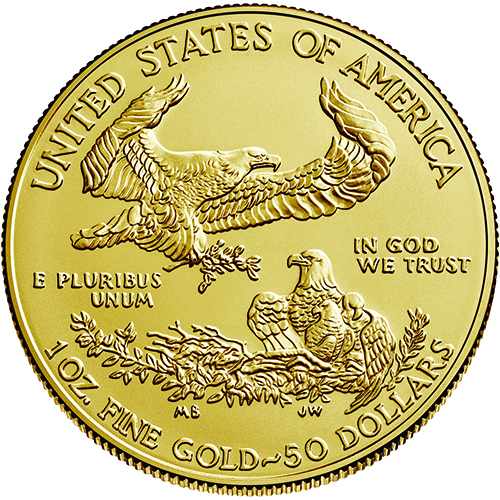
Gold has always held a tremendous fascination for humanity. Its beauty, rarity and durability combine to give it a timeless appeal and great value. Here are four gold coins to how to buy them.
Gold coins, like all coins, are hand-held pieces of history. They outshine virtually all other coins because their main component is so coveted, so admired and so prized. Many U.S. gold coins rank high on collectors’ lists.
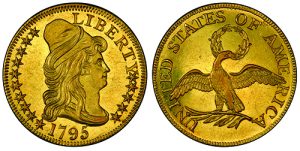
(PCGS)
The history of gold is to rise in price dramatically and then abruptly retreat. The gold market historically has been shattered by volatility and by sharp ups and downs. These events have served to magnify the risks for those who venture into this market. But at the same time, it also has created opportunities for those with the savvy and wherewithal to use the peaks and valleys to their advantage.
Generic Gold Coins
When buying physical gold coins, it’s crucial to understand the difference between “generic” gold coins and those that are genuinely rare. Generic coins exist in sufficient quantities to be traded as like-kind units—very much like commodities. These coins may be in high levels of preservation; more often than not, in fact, those traded frequently in the current marketplace are in mint-state condition. But they’re readily available in those grades, so buyers and sellers have quick access to supply sources. And one is treated much like any other so that these coins are interchangeable. Common-date Saint-Gaudens double eagles ($20 gold pieces) are viewed, for example, as generic coins.
Many generic gold coins can be purchased for prices close to the melt value of the metal. That’s because precious-metal content forms an integral part of generic gold coins’ value. This occurrence is particularly true for coins in high circulated grades, such as About Uncirculated-55 or 58. Additionally, it’s true of low-end uncirculated grades such as Mint State-60 through 62. In these preservation levels, generic gold coins are virtually “bullion” coins: They command just a modest premium over the market value of the metal they contain. They rise and fall in value as the precious metal itself goes up or down in price. The price differential widens considerably as the grade level moves up to Mint State-63 and above.
Rare Gold Coins
By contrast, truly rare coins are one-of-a-kind pieces, and each has its personality. Low mintage or availability, combined with high quality, are key determining factors in their value. Some, of course, possess not only rarity but also higher than high quality—and that combination greatly enhances their value. But unlike generic coins, truly rare coins are treated first and foremost as collectibles, not commodities; they’re regarded as distinctive, rather than interchangeable.
Here’s a list of four kinds of gold coins that are truly golden.
1. The One-Ounce Gold American Eagle Bullion Coin
This popular bullion coin has a face value of $50, and its obverse design was adapted from the famed Saint-Gaudens double Eagle (or $20 gold piece), with a regal Miss Liberty in full stride. Many buyers find the design appealing. They also like the idea of “buying American.” They prefer the fineness of 22-karat because, being harder than pure gold, it makes the coin relatively durable.
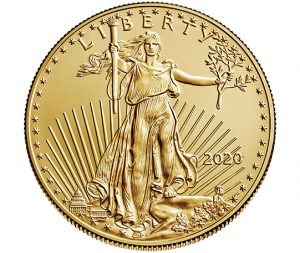 The American Eagle trades at seven or eight percent above its bullion value. So, if gold is trading at $1,773 per troy ounce, an American Eagle will cost about $1,915. The price could be a little more or less, depending upon the dealer’s services. Some dealers will charge a lower premium when they sell in quantity – say, 50 or 100 coins at a time. Other dealers may charge nine or 10 percent but will take time to sit down and talk with you, even if you’re buying just one coin.
The American Eagle trades at seven or eight percent above its bullion value. So, if gold is trading at $1,773 per troy ounce, an American Eagle will cost about $1,915. The price could be a little more or less, depending upon the dealer’s services. Some dealers will charge a lower premium when they sell in quantity – say, 50 or 100 coins at a time. Other dealers may charge nine or 10 percent but will take time to sit down and talk with you, even if you’re buying just one coin.
Quick Tip: Whenever you buy bullion coins, always check dealers’ spread – the difference between what they are paying to buy a coin and what they are charging when they sell the same coin. A narrow spread is the mark of an honest dealer. If you see a range spread of 20 or 30 percent, you might want to go elsewhere.
There is one additional reason to buy gold American Eagles: The U.S. government allows the inclusion of these coins in Individual Retirement Accounts – something it does not permit with foreign bullion coins. Before doing this, check with a qualified financial advisor. Your coins would need to be stored with an Internal Revenue Service-approved custodian.
The gold American Eagle is a very liquid coin, easy to sell, and among the hottest coins on the market. It’s a great coin to have – or to give. However, one market tip is to steer clear of these coins bearing the year you are buying them in. The U.S. Mint charges its distributors a hefty premium, passed on to the consumer, for current-year coins. That premium often dissipates as early as the following year.
It’s important not to pay significant premiums for American Eagle gold coins on the basis that they are collectible. But as an investment, these are wonderful coins to have and a great insurance policy – something that will be there when you need it if times get really tough. The fractional Gold Eagles carry very high premiums and these should be bought only as an insurance policy. Being identical in design to the one-ounce version, they’re also highly recognizable. Through the years, their primary use has been in jewelry.
2. Saint-Gaudens Double Eagles
Saint-Gaudens double eagles certified as Mint State-65 by the Professional Coin Grading Service (PCGS) or the Numismatic Guaranty Corporation of America (NGC) and verified for grade by the Certified Acceptance Corporation (CAC) are second on the list.
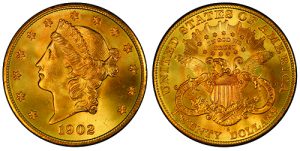
(PCGS)
The “Saint” has been acclaimed for nearly a century as the most magnificent coin ever minted by Uncle Sam. Its beautiful design, by renowned sculptor Augustus Saint-Gaudens, has made it an unusually popular collectible ever since it first appeared in 1907, especially in gem condition – which MS-65 certainly is.
In July 2002, one Saint-Gaudens Double Eagle, the 1933 specimen, changed hands at a New York City auction for $7.59 million (plus a $20 monetization fee) – the highest price ever recorded for a Saint-Gaudens double eagle.
Other dates will cost you considerably less than $7.59 million. Common-date pieces with the CAC seal of approval are selling for about $2,400 in MS-65. That’s a real deal for coins in this exceptional level of preservation. As rising bullion prices bring more and more buyers into the market, these coins could easily double in value, as could gold bullion itself, within the not-too-distant future.
3. Liberty Head Double Eagles
Liberty Head double eagles graded MS-63 by PCGS and NGC make the third choice. This recommendation applies to Type 3 “Lib” $20s – those struck from 1877 through the end of the series in 1907. For the most part, these are more common than earlier dates and bring very nominal premiums in MS-63. These Type 3 coins can be obtained today for only about $2,100 in this very attractive (though less than gem) condition – and keep in mind; a double eagle contains very nearly a troy ounce of gold (0.9675 troy oz).
At this kind of price, these coins, like gold itself, have an excellent chance of doubling – or even tripling – in value as the bullion market moves higher and numismatic coins tag along. Liberty double eagles don’t have the majesty of their Saint-Gaudens successors. Still, they are older, generally have lower mintages and are steeped in history. The roots of these coins date back to the California Gold Rush of the late 1840s. Owning one of these gives you a piece of the past that is also an investment for the future.
4. Capped Bust Facing Right $5 & $10 Gold Pieces
Capped Bust Facing Right $5 and $10 gold pieces from the late 1700s and early 1800s, as well as proof gold coins through the early 1900s rank fourth on the list.
This is the bread and butter of the marketplace for premium rare gold coins. You get something that looks like a Rembrandt with an extraordinarily scarce date – for example, a 1795 $10 gold piece in Mint State 63. That small-eagle-reverse $10 is the epitome of Rembrandt-like collectible coins. It’s truly a museum piece, a sight to behold.
That whole family of early American coins – whether Mint State-63 or even XF-45 – has an undeniable aura. There’s something almost mystical about a coin with a date of 1795 or 1796 or 1801. These coins have panache and a magical luster that gives them the appearance of having been minted yesterday.
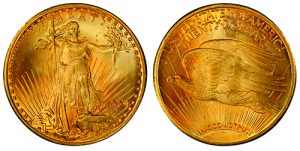
(PCGS)
The Capped Bust Facing Right $5 and $10 gold pieces fill the bill as magnificent, museum-quality works of art that preserve wealth. Besides being expensive, they’re also fantastic coins. These gold coins, struck between 1795 and 1807, are classic gold pieces, and up until just a few years ago, people were willing to pay almost any price for them. They only recently saw some declines in value, with the graying of the coin industry. Now, they’re starting to come back with slow confidence that belies growing future interest.
Nice examples already trade for six-figure prices, and I look for them to rise in value sharply in 2021 and beyond. These early U.S. gold coins offer collectors and investors the convenience of great portability. If you needed to go somewhere with a small coin worth big money, a Capped Bust Facing Right $5 or $10 gold piece worth $300,000 in your pocket would foot the bill.
Vintage-Proof Gold Coins
Vintage-proof gold coins from the 1800s through the early 1900s have an almost magical quality. The combination of shimmering precious metal and exquisite minting detail makes these coins spectacular to behold. And their high intrinsic value makes it clear that they belong on a very high pedestal. All proof gold coins – including “matte” proofs, which have a sandblast appearance – should do extremely well in the coming years as gold coins increase in value and demand for gold, in general, continues to grow. But brilliant proof gold coins will clearly be the biggest winners of all. And since they provide the most appealing showcases, the rarest and most pricey brilliant pieces will be in the greatest demand.
Gold overall, and early gold coins in particular, are tremendously underheld. Affluent collectors and investors are coming to appreciate how rare and desirable they are. Gold bullion and rare gold coins do indeed appear to be headed for the Moon. So it might not be a bad idea to make a reservation for the rocket ride. And even if that rocket trip turns into a roller-coaster ride, that can be exciting and even ultimately rewarding.
So what are you waiting for? Go for the CAC-verified early gold coins and proof gold coins—and the CAC MS-65 Saints, too. Go for the gold, which will go to the Moon!
This story about buying gold coins previously appeared in COINage magazine. Story by Scott A. Travers. To subscribe to COINage magazine click here.

